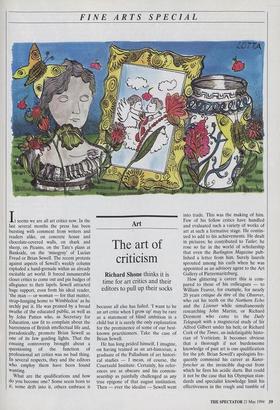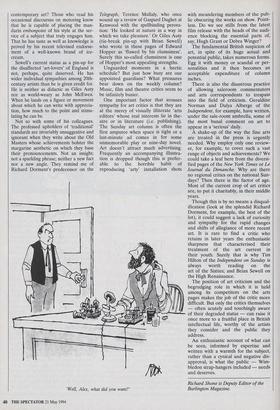FINE ARTS SPECIAL
Art
The art of criticism
Richard Shone thinks it is time for art critics and their editors to pull up their socks
It seems we are all art critics now. In the last several months the press has been bursting with comment from writers and readers alike, on concrete house and chocolate-covered walls, on shark and sheep, on Picasso, on the Tate's plans at Bankside, on the 'misogyny' of Lucian Freud or Brian Sewell. The recent protests against aspects of Sewell's weekly column exploded a hand-grenade within an already excitable art world. It forced innumerable closet critics to come out and pin badges of allegiance to their lapels. Sewell attracted huge support, even from his ideal reader, 'the man — or woman — for that matter, strap-hanging home to Wimbledon' as he archly put it. He was praised by a broad swathe of the educated public, as well as by John Patten who, as Secretary for Education, saw fit to complain about the barrenness of British intellectual life and, paradoxically, promote Brian Sewell as one of its few guiding lights. That the ensuing controversy brought about a questioning of the function of professional art critics was no bad thing. In several respects, they and the editors who employ them have been found wanting.
What are the qualifications and how do you become one? Some seem born to it, some drift into it, others embrace it because all else has failed. 'I want to be an art critic when I grow up' may be rare as a statement of blind ambition in a child but it is surely the only explanation for the prominence of some of our best- known practitioners. Take the case of Brian Sewell.
He has long prided himself, I imagine, on having trained as an art-historian, a graduate of the Palladium of art histori- cal studies — I mean, of course, the Courtauld Institute. Certainly, his refer- ences are as obscure and his connois- seurship as painfully challenged as any true epigone of that august institution. Then — ever the idealist — Sewell went into trade. This was the making of him. Few of his fellow critics have handled and evaluated such a variety of works of art at such a formative stage. He contin- ued to add to his achievements. He dealt in pictures; he contributed to Tatler; he rose so far in the world of scholarship that even the Burlington Magazine pub- lished a letter from him. Surely laurels sprouted among his curls when he was appointed as an advisory agent to the Art Gallery of Pietermaritzburg.
How glittering a career this is com- pared to those of his colleagues — to William Feaver, for example, for nearly 20 years critique du titre of the Observer, who cut his teeth on the Northern Echo and the Listener while simultaneously researching John Martin; or Richard Dorment who came to the Daily Telegraph with a magisterial study of Sir Alfred Gilbert under his belt; or Richard Cork of the Times, an indefatigable histo- rian of Vorticism. It becomes obvious that a thorough if not burdensome knowledge of past art is one qualification for the job. Brian Sewell's apologists fre- quently commend his career as Kunst- forscher as the invincible dug-out from which he fires his acidic darts. But could it not be the case that his Olympian stan- dards and specialist knowledge limit his effectiveness in the rough and tumble of contemporary art? Those who read his occasional discourses on motoring know that he is capable of placing the man- darin embonpoint of his style at the ser- vice of a subject that truly engages him. That he has taste as well as knowledge is proved by his recent televised endorse- ment of a well-known brand of ice- cream.
Sewell's current status as a pin-up for the disaffected 'art-lovers' of England is not, perhaps, quite deserved. He has wider individual sympathies among 20th- century artists than he is given credit for. He is neither as didactic as Giles Auty nor as world-weary as John McEwen. When he lands on a figure or movement about which he can write with apprecia- tion, how much to the point and stimu- lating he can be.
Not so with some of his colleagues. The professed upholders of 'traditional' standards are invariably unsuggestive and ignorant when they write about the Old Masters whose achievements bolster the margarine aesthetic on which they base their pronouncements. Not an insight; not a sparkling phrase; neither a new fact nor a new angle. They remind me of Richard Dorment's predecessor on the Telegraph, Terence Mullaly, who once wound up a review of Gaspard Dughet at Kenwood with the spellbinding perora- tion: 'He looked at nature in a way in which we take pleasure.' Or Giles Auty (tie-break pin-up with Brian Sewell) who wrote in these pages of Edward Hopper as 'flawed by his clumsiness'. Surely this so-called clumsiness is one of Hopper's most appealing strengths.
Unguarded moments in a hectic schedule? But just how busy are our appointed guardians? What pressures bear down on the weekly column? Music, film and theatre critics seem to be infinitely busier.
One important factor that arouses sympathy for art critics is that they are at the mercy of visually illiterate 'arts editors' whose real interests lie in the- atre or in literature (i.e. publishing). The Sunday art column is often the first amputee when space is tight or a last-minute ad comes in for some unmemorable play or nine-day novel. Art doesn't attract much advertising. Frequently an accompanying illustra- tion is dropped though this is prefer- able to the horrible habit of reproducing 'arty' installation shots 'Well, Alex, what did you want?' with meandering members of the pub- lic obscuring the works on show. Point- less. Do we see stills from the latest film release with the heads of the audi- ence blocking the essential parts of, say, Hugh Grant or Debra Winger?
The fundamental British suspicion of art, in spite of its huge actual and potential public, takes numerous forms. Egg it with money or scandal or per- sonalities and it then becomes an acceptable expenditure of column inches.
There is also the disastrous practice of allowing saleroom commentators and arts correspondents to trespass into the field of criticism. Geraldine Norman and Dalya Alberge of the Independent, for example, have written, under the sale-room umbrella, some of the most banal comment on art to appear in a 'serious' daily.
A shake-up of the way the fine arts are treated in the press is urgently needed. Why employ only one review- er, for example, to cover such a vast range of objects and achievements? We could take a leaf here from the diversi- fied pages of the New York Times or Le Journal du Dimanche. Why are there no regional critics on the national Sun- days? Then there is the factor of age. Most of the current crop of art critics are, to put it charitably, in their middle years.
Though this is by no means a disqual- ification (look at the splendid Richard Dorment, for example, the best of the lot), it could suggest a lack of curiosity and sympathy for the rapid changes and shifts of allegiance of more recent art. It is rare to find a critic who retains in later years the enthusiastic sharpness that characterised their treatment of the art current in their youth. Surely that is why Tim Hilton of the Independent on Sunday is always worth reading on the art of the Sixties; and Brian Sewell on the High Renaissance.
The position of art criticism and the begrudging role in which it is held among its competitors on the arts pages makes the job of the critic more difficult. But only the critics themselves — often acutely and touchingly aware of their degraded status — can raise it once more to a fruitful place in British intellectual life, worthy of the artists they consider and the public they address.
An enthusiastic account of what can be seen, informed by expertise and written with a warmth for the subject, rather than a cynical and negative dis- approval, is what the public — Wim- bledon strap-hangers included — needs and deserves.
Richard Shone is Deputy Editor of the Burlington Magazine.





































































 Previous page
Previous page